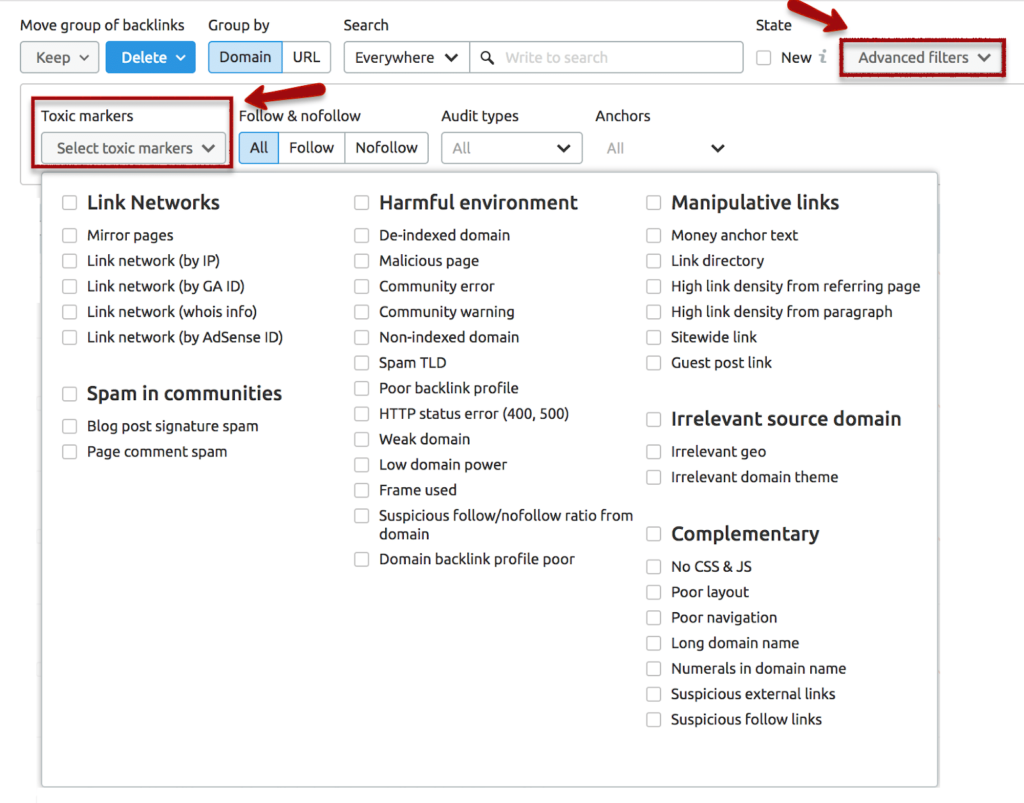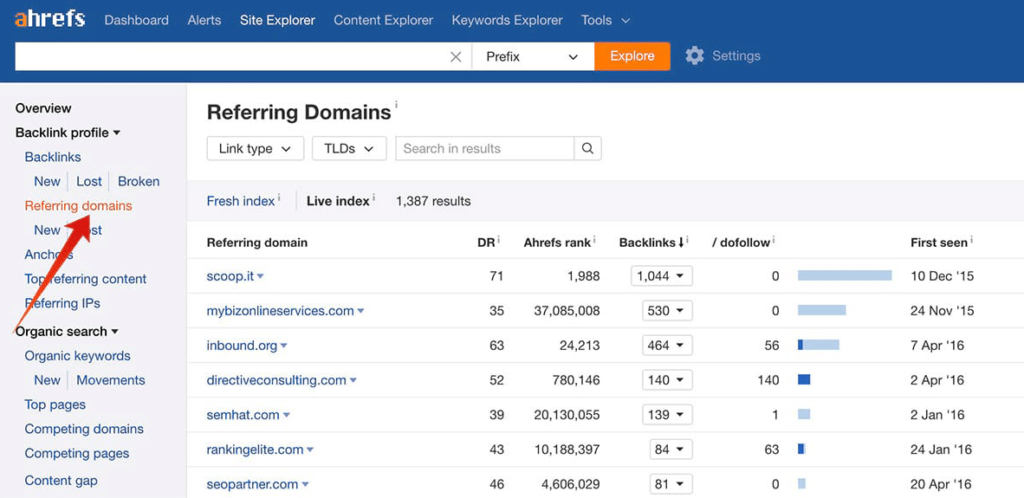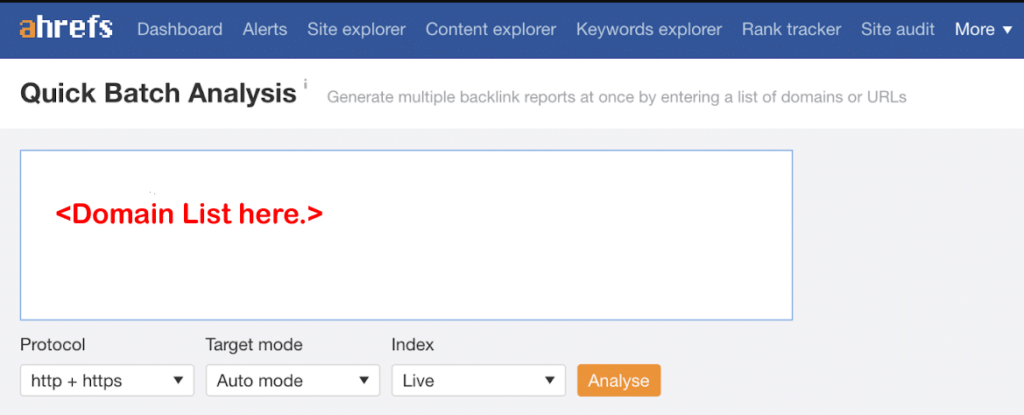
Quick Links
7 Simple Steps to Increase Website Backlinks
Link building is one of the most critical SEO activities to focus on to improve search engine rankings and to drive sales lead growth. Here are seven simple steps to increase website backlinks.
1. Establish your backlinks baseline.
3. Do your competitor backlinks research.
4. Define your target audiences.
5. Different audiences and different types of content.
6. Create high-quality content worthy of linking to.
7. Effective link building tactics.
Often, a common problem I see with clients is that they usually start with step #6 and bypass all the fundamental steps needed to implement a successful backlinks program (steps 1-5).
 #1) Establish Your Backlinks Baseline.
#1) Establish Your Backlinks Baseline.
 Before you begin any link building efforts, it is vital first to establish a baseline. This involves performing a link analysis using tools like Ahrefs, Google Search Console, and SEMRush.
Before you begin any link building efforts, it is vital first to establish a baseline. This involves performing a link analysis using tools like Ahrefs, Google Search Console, and SEMRush.
I use Ahrefs as my primary tool to do backlink profile research. You can obtain a wealth of information including the total number of backlinks, the number of referring domains, new and lost referring domains, anchor text, broken links, internal links, and other valuable information. Ahrefs will also show organic rankings for specific URLs and paid search keywords.
You can also get link data from Google Search Console. Log into your Google Search Console and navigate to the Links Report. Here you will find information on external website link domains and link text used.
✔️ Total number of backlinks
✔️ Total number of referring domains
✔️ Total lost backlinks
✔️ Total new backlinks
✔️ Total broken backlinks
✔️ Total toxic backlinks
✔️ Dofollow vs. nofollow links
#2) Get Rid Of Toxic Links.
A toxic backlink means any site that links to your website that can decrease your SEO rankings. Some examples include paid link farms, foreign private blog networks, sites with viruses or malware, and mirror pages (identical pages found on different domains that link to your website.)
According to Google, you should first contact the specific website where you want your link to be removed. If this does not work, then have links disavowed through Google’s Disavow Tool. You can only submit one disavow list per domain, and it usually takes two weeks to be processed.
Two of the best tools to examine your backlinks for toxic links are SEMRush and Ahrefs.
SEMRush’s Backlink Audit examines 40 toxic markers. Each link is scored from 0 to 100. Scores between 60 to 100 are considered toxic links. Ratings from 45-59 are possibly toxic. You can add domains to your disavow list and upload them through Google’s Disavow Tool.

Ahrefs Site Explorer is an excellent tool to examine your site for toxic links. You will then run the “Referring Domains” report. I recommend re-ordering the Report by DR (Domain Rating) to show the lowest to highest scores.

Review the link domain list for things like websites you don’t recognize, foreign language websites, and artificially looking/spammy website anchor text.
Manually review each link by clicking on the URL. If you confirm it is a bad link, add it to your disavow list. Disavow lists can be exported from Ahrefs (in the proper format) and uploaded to Google’s Disavow Tool.
#3) Do Your Competitor Backlinks Research.
Competitor research can tell you what level of SEO your competitors are implementing. For Example, the backlink analysis can tell you whom they get backlinks from, what terms they bid on, and what terms they rank for organically. The information is beneficial and can be used to outperform your online competition.
When picking competitors, choose both your traditional competitors and online competitors.
Use Ahrefs or do a Google search for your product or service category. For Example, I will use “top paid search metrics.” In the search engine results pages (SERPS), you will see results like HubSpot, WordStream, Search Engine Land, or Search Engine Journal.
Take your competitor domains and run an analysis using the “Ahrefs Batch Analysis Tool.”

The Report will provide you critical metrics like Domain Rating, the number of referring domains, estimated organic traffic, and the number of search term rankings.
Once you have your baseline metrics, examine the domains in more detail by using Ahrefs Site Explorer / Referring Domains report. (You will want to set the filter to “Dofollow” links for the analysis.)
Look for domains with high link activity to your competitor websites. These sites make excellent prospects to develop relationships with. Find 5-10 websites for each of your competitors and add the list to your Excel research document.
Next, look at what keywords your competitors are ranking for by using the “Organic Keywords” report. When examining this Report, filter out branded terms using Ahrefs exclude filter option.
Last, examine the content competitors rank for, but you do not. Ahrefs Content Gap analysis shows your competitors that rank in the top 10 search results. It is best to filter your list by choosing search volumes (500+ monthly searches) and keyword difficulty scores (choose Min~20.)
#4) Define Your Target Audiences.
Once you have completed your competitor research, you will have groups of keywords and content you do not rank for. And based on your research pulled from Ahrefs, SEMRush, and Google Search Console, you will have backlink categories you will target for your link building efforts.
Backlink categories can include online business relationships, niche directories, blogs, industry publications, targeted press releases, industry experts, influencers, and other groups.
Whom you obtain a potential backlink will largely depend on how difficult it will be to rank for that term, number of monthly searches, business relevance, and the extent you will need to update or create new content.
#5) Different Audiences And Different Types Of Content.
 Link building usually requires creating new content, updating old content, or taking existing content and putting a fresh spin on it.
Link building usually requires creating new content, updating old content, or taking existing content and putting a fresh spin on it.
Depending on the website, you will need to match that website’s content needs and style.
For Example, to obtain links from an industry-specific blog, a good piece of content could be a summary of results from an industry survey you recently completed.
If obtaining links from a B2C blog, a product comparison article could be a good fit. The key is to create high-value content that would be of value to the website’s visitors.
The best types of content to obtain backlinks include:
✔️ Listicles (an article made up of a list) Example: “7 cleaners to get rid of rust marks.”
✔️ Guides (an in-depth resource on a specific topic)
✔️ Infographics (survey results, statistics, and step-by-step topics work well)
✔️ Local links (your local community can be a great source of links, including local business directories, local professional memberships, sponsorships, and other local blogs)
✔️ Survey results and statistics (original research done by your company can garner 10s to 100s of backlinks)
✔️ White papers (an in-depth examination of a topic of interest to your audience)
✔️ “How-to” posts (always a good bet to receive backlinks)
✔️ Interview posts (subject matter expert content)
#6) Create High-Quality Content Worthy Of Linking To.
 If you are going to increase your backlinks, you will need to create quality content that someone would link to.
If you are going to increase your backlinks, you will need to create quality content that someone would link to.
Here are standard best practices to follow.
✔️ Make the content relevant, engaging, and unique to your audience.
✔️ Use a simple, conversational writing style.
✔️ Use high-quality graphics (originally designed images, infographics, and charts.) Use DIY graphic tools like Canva, Venngage, or Picktochart.
✔️ Write evergreen content (content that stays relevant.)
✔️ Provide value (make your content actionable and useful.)
✔️ Use credible sources (back up your content with expert and authoritative citations.)
✔️ Check your grammar and spelling (use Grammarly, ProWritingAid, or other writing tools.)
✔️ Write medium to long-form content (depending on your industry and topics, 2,000+ words.)
✔️ Answer common questions asked by your customers.
✔️ Get social proof through votes, comments, and shares.
✔️ Optimize your headlines to capture interest and attention.
✔️ 80% of your content should focus on educating and engaging the reader, and 20% or less on selling your company’s products, services, or solutions.
✔️ When possible, leverage trending topics within your industry.
#7) Effective Link Building Tactics.
An entire book can be written about link building tactics.
For the sake of time, I will focus on some of the most effective link building tactics for 2020.
✔️ Low-Effort Link Tactics:
1. Resource pages:
These pages provide outbound links to helpful resources around a specific topic.
You can find these pages by doing a Google search for “search term” + useful links or “search term” + helpful resources.
2. Broken Links:
This is discovering broken pages from authoritative (and competing) sites in your industry.
Use Ahrefs Site Explorer to find broken links quickly.
3. Brand or company mentions:
This occurs when a website mentions your name or company but does not include a link to your site.
Contact the website owner and ask if they could include a link with your mention.
4. Business directories:
This refers to submitting your website to industry-specific or local business directories.
5. Existing business relationships:
Odds are you work with a bunch of business in which you have a relationship with. These provide excellent resources to get listed on their where to buy pages, supplier or resources pages, and other relevant pages.
✔️ Medium-Effort Link Tactics:
1. Guest blogging:
The goal here is to write high-quality content and get it posted by an industry website that accepts guest posts.
2. Blog interviews:
Conduct interviews with top subject matter experts within your industry.
3. Create original infographics:
Based on your company’s market or industry survey, create unique infographics from key summaries and insights.
4. Update old content:
Whether it is old blog content or white papers, updating and refreshing existing content can be an excellent tactic to grow backlinks.
5. Help a Reporter Out (HARO):
If you can become a resource for a journalist, this can provide excellent resource for ongoing link building tactics.
✔️ High-Effort Link Tactics:
1. Conduct industry survey:
Create your industry survey. The data and insights you collect make excellent content that many websites will be glad to share and link to your survey results and insights.
2. Create a tool:
Develop a tool that prospective customers would use and find valuable.
3. Develop skyscraper content:
Developed by Brian Dean, this tactic is where you find link-worthy content, make something bigger and better, and find relevant websites to link to your skyscraper content.
4. Develop an ultimate guide:
This is where you cover a specific topic in great depth; more so than most online competitors. Long-form content provides a wealth of actionable and valuable information.
5. Develop a free, online course.
This can be an extension of your ultimate guide or a stand-alone content piece. This is an excellent way to build authority, trust, and expertise within your industry.
Final Thoughts
It this article, we discussed seven steps to increase backlinks in 2020, which range from establishing your baseline link metrics to executing various link building tactics such as broken links or industry surveys. The best link building analysis tools include Ahrefs, SEMRush, and Google Search Console.
Link building is one of the most critical, ongoing steps in an effective SEO strategy. Follow the seven steps, and you will be on the path to increasing your rankings, boosting leads, and driving sales growth.
Learn more about Corey Wenger National SEO Consulting Services, Local SEO Consulting Services, SEO Consultant Services, Technical SEO Audit or SEO Audit Services.
About the Author
Corey has over 20 years of Digital Marketing and SEO experience and is the owner of Corey Wenger SEO Consulting. Corey is an SEO Expert and Consultant and has deep knowledge in troubleshooting, educating, coaching, guiding, and scaling your SEO Strategies and tactics so that you can increase keyword rankings, leads, and sales. Additionally, Corey helps businesses develop SEO Strategies to compete more effectively against search engine competition. Corey is also an SEO Trainer and enjoys helping his clients learn and master SEO tactics, tools, and strategies.
Ready to get your SEO Audit started?

